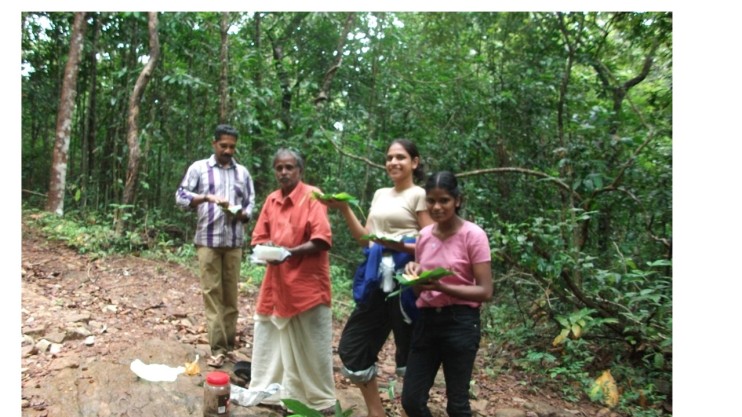By Keerthikrutha Seetharaman

The forest departments in the Western Ghats of South India receive support from a section of temporary staff known as ‘watchers’. They are usually daily wage workers and members of the local community. Their knowledge on animal behavior and the connect which they display to their natural surroundings have never failed to bring a smile of admiration and a sense of joy to me.
It was in Mangarai that I took part in my first wildlife census in 2008. Mangarai is a place on the way to the Salim Ali Centre for Ornithology and Natural History (SACON) from the city of Coimbatore. It lies somewhere near the green patches which are sandwiched between the agricultural lands of Coimbatore city and the settlement of Anaikatti (Fig.1). It was here that I met a kadar tribal whose name I fail to recall. As he was about to enter the forested area he bowed down touched the earth and brought his hands in a gesture of reverence to the forest. I asked why he did that, he said, if we respect and revere the forest, it will take care of us.

Fast forward to 2013, my team and I were at Chinnar Wildlife Sanctuary, Kerala. We were surveying the sanctuary for frogs as part of a study on understanding the presence and distribution of the chytrid fungus in the Western Ghats biodiversity hotspot. In the Western Ghats, there are two animals that I have heard the watchers say they fear most: one is the elephant and the other the sloth bear. In Chinnar, we walked to our sampling sites observing signs of their presence such as fresh dung and footprints. I was curious to know what we should do if we did encounter elephants and asked our watcher. He said it’s a good idea to run, but it’s a better idea to run in a zig-zag manner which will confuse the animal. He paused thought for a few seconds and added, “I once knew a man who had been charged by an elephant and all he did was hold his ground, brought his hands in a gesture of prayer and bowed to the elephant, he said the animal calmed down and retreated”.
In Kalakkad Mundanthurai Tiger Reserve in 2014, I had met one Mr. Siva Kumar, a Kani tribal who was versed in the Latin names of some of the plants and animals in the area and had the experience of working with ecologists. He taught me that one of the best ways to look for an elephant is to keep a watch for its smell. When you visit a zoo with an elephant enclosure a pungent smell of the dung prevails, this same smell is the smell to watch for when watching for elephants in a forest. Some say, that if you are sharp enough you can smell it from almost half a kilometer away, though I have my own doubts about that. At another instance Sivakumar anna (Anna is elder brother in Tamil) recounted an encounter with a Tiger when he was a child, he was walking along with his father and the Tiger growled in a particular way and his father said son, the Tiger is not in a good mood today let us take another direction.
Their memories, experiences and encounters are not documented. There may be a lack of evidence, but there is also room to say that their stories are possible. If these people had been provided the type of formal education which trains them to document and provide evidence then they could be held up to criticism. During most of these interactions I have felt a sense of discontent from the watchers due to their lack of qualifications or a formal education. Some of whom I have met lack the ability to carry out a simple multiplication or division. In spite of some of them being highly knowledgeable in the ways of the forest and dedicated to the cause of wildlife conservation and preservation, this drawback has prevented them from looking for promotions and more lucrative opportunities. Sometimes I wonder if a dedicated program using open resources which are available such as Khan Academy classes could be used for schooling and perhaps even provide them with a formal education. At the same time, I also wonder if they are provided with those opportunities would they still continue to be a part of the forest as they are today?
That’s a different debate altogether. In conclusion, I have now realised that one of the reasons why I do science outside is to learn from these people. The people to whom the forest means more than trees, animals, plant-animal interactions, ecosystems and a showcase of evolutionary biology, to whom it means ‘Home’ and is a living entity which is to be respected and revered.

Keerthikrutha Seetharaman is trying to conserve forests in India.
I’m glad Keerthi has taken effort to share her experience n condition of Watchers n Shramiks. This issue or gap as it’s left unnoticed. We often fail to realise that actual work on ground is done by them in conserving forests in India. In my experience, I have seen they know the forest better than many of us inc. officials n even researchers. They know everything like location, behaviour of animals and nook n corner of forests. Theyre hardworking people but under paid and exploited in many parks. If there can be some provision to train n develop them to get better opportunities and more stable jobs, this will encourage them n greatly improve their lives which they deserve.
LikeLike